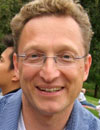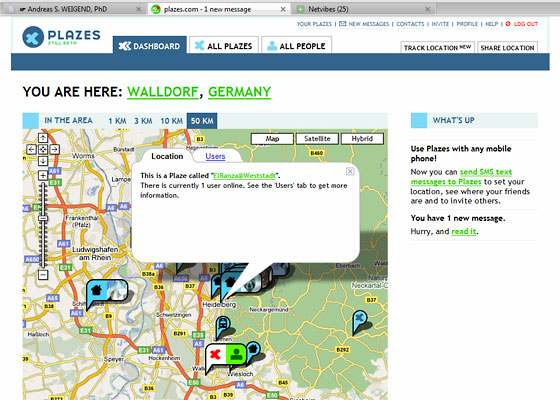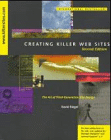Looking into the Future: Web 4.0
By Gerd Waloszek
To overview of UI Design Thoughts
At a user experience meeting in my company, a colleague gave an interesting presentation about Web 2.0, the "social Web." He stated: "It's more an attitude than technology" – even though he admitted that some technology is involved. Most of us are still deeply rooted in Web 1.0, that is, in the dull past. For example, the SAP Design Guild Website, for which I work, is based on old-fashioned static HTML pages – barely "enriched" by a few include statements. Many company Intranets are more or less a "classical" content management systems, which my colleague also listed among the Web 1.0 beasts. He contrasted these with Wikis, and indeed many companies are moving in the direction of using wikis as a replacement for or as an addition to their Intranets.
 |
 |
|
| Marc Smith, Microsoft Research |
Andreas Weigend, Stanford University |
When another colleague of mine and I attended a Media Symposium in Bonn in November 2006, we both felt the Web 2.0 hype there, too. We learned that some people even compare Web 2.0 to, among others, the upright walk of men. At the symposium, Microsoft's Marc Smith, who keeps " a close eye on newsgroups and other public e-mail lists" stated that during our lives we will leave about 4 TB (Tera Bytes) of digital traces behind. I doubt that. I would rather assume that our traces will exceed this number by a factor of 10^6 or more (as an ex- physicist, I like powers of tens – this would be 10^15, still far below Avogadro's famous number of 10^23). Think only of the many eBay evaluations and back-evaluations that we are supposed to provide (I refuse that recently). In his talk, Marc Smith presented an illustration, which showed his jogging path through a park and his drive to the park. All that had been tracked and recorded via GPS. In his presentation, Leif recalled the example of Andreas S. Weigend, former Chief Scientist of Amazon, who strives for being accessible any time, anywhere. You can go to the www.weigend.com or the Plazes Website (of course, a Web 2.0 site) and track him – if you are inclined to do so... I have different feelings and goals in this respect. In my opinion, it is not necessary that the whole world knows where I am every moment of my life. Actually, I even hate to be accessible any time, anywhere. But such a point of view seems to be somewhat outdated these days. I guess, I had better lived around 1500, which was also an interesting era – but without all that distracting electronic stuff, which now eats up most of my time and attention.

Figure 3: The Plazes Website
All in all, Web 2.0 is getting more and more public attention and is going to replace Web 1.0 soon. For details on such "technological replacements," I suggest that you read Bruce Sterling's book "Shaping Things" (or my review of his book)... There, you will also learn that the old technology will survive in one or the other way. So, what's next? As we all know, at the moment a paradigm becomes established, there are a few people already moving forward and thinking of the next steps.
Not surprisingly, the next step is called Web 3.0, as my colleague explained. And what the hell will Web 3.0 offer? According to him, Web 3.0 will be the "semantic Web," that is, a Web where every information piece is tagged so that it can be reused in manifold ways (or listen to A. Weigend's audio podcast). Think of Web 3.0 more or less as an XML Web. (I know, this is a simplified picture.) But if this new Web will be "pure information," isn't that more or less what the inventors or the Web like Tim Berners-Lee originally intended? Are we returning to the old hypertext visions of Vannevar Bush and others? If so, it's fairly easy to predict what Web 4.0 will become. But I am not sure, whether I should disclose this secret here already. Shouldn't I better apply for a patent first? (Some companies already applied for patents with respect to the Web 2.0 stuff.)
As I cannot keep secrets, let me digress a little first to increase your tension. When I became a member of SAP's usability group in 1993, the group from time to time issued a newsletter, called "Cogito Ergonom." (OK, that was in the previous millennium, as the name shows.) I managed to launch a few satires in this newsletter, while some that I had in stock have never been published. Among these was a story about "the new R/3." This story had been inspired by magazine articles, which criticized graphical user interfaces ("colorful stamps"). In the story, I reported about a secret team that set off to develop a successor to R/3 – without mouse, menus, and the typical GUI stuff. I called this new system "R/3-1." (Some people might be reminded of R/3's predecessor R/2 by this.)

Figure 4: The predecessor to the forthcoming book...
Having told this story, it should be even easier for you to predict what Web 4.0 will be: A guy called Dave Beagle will write a book titled "Designing Terminator Websites" and describe how graphic designers can bring life into the dull Web 3.0 by misusing XML tags and making pages look like they want them. And aren't they right? With the advent of content management systems, the "dull Web" movement started, and Web 3.0 will make the Web even duller. Therefore, designers will put new efforts in persuading customers to invest in graphic design and increase their revenues. So, Web 4.0 will be the "aesthetic Web," but I think it's too early for fixing this term now.
Oh my god, I start trembling – I see the next dot.com crash coming! Quick, quick, take the crystal ball away!
References
- Stanford homepage of Andreas S. Weigend: www-psych.stanford.edu/~andreas/
- Website of Andreas S. Weigend: www.weigend.com
- Audio podcast by A. Weigend: Web 3.0 – Architectures of Interaction
- Marc Smith (Microsoft Research): research.microsoft.com/~masmith/ – research.microsoft.com/community
- Review of Shaping Things (Bruce Sterling) (SAP Design Guild)
- Plazes Website: beta.plazes.com/
Originally Published: 03/19/2007 - Last Revision: 01/31/2009
Gerd Waloszek |
made by |
